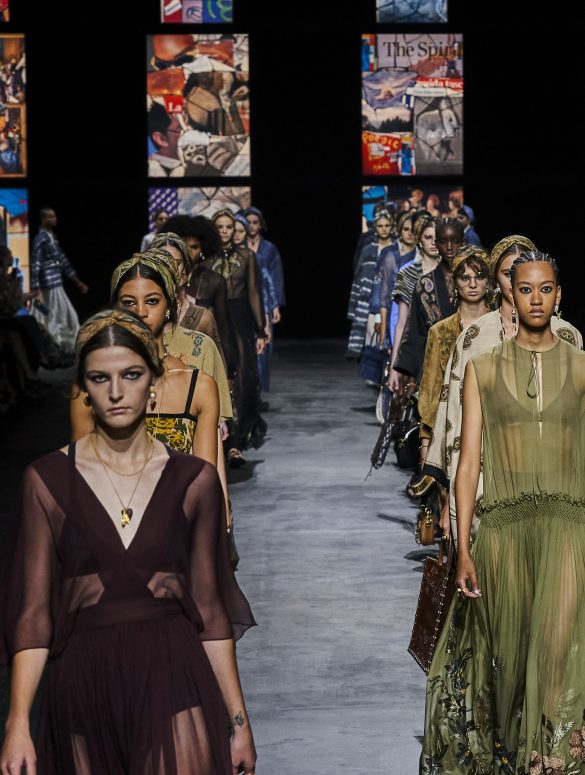Review of Dior Spring 2021 Fashion Show from Paris
The Intellect of Clothes
By Long Nguyen
Fashion is a collage of different references, a way to maintain a sense of memory but also a way to move to the future.
– Maria Grazia Chiuri, via a Zoom call about her Spring 2021 Dior Collection
“It is also something very human,” Chiuri added, “altogether on the stage for this moment.” And what a stage it was as Chiuri was speaking to us from inside a tent converted to a cathedral stage complete with stain glass windows created by the Italian artist Lucia Marcucci. Inside a group of twelve women opera singers performed a funeral ode directed by Catherine Simonpietri in a live show inside the Tuileries gardens that perfectly fused the Dior heritage of art and fashion within the current context both on the cultural and on the personal level in this moment of sudden upheavals.
A fashion show is also a ritual, it’s about all the people getting together, to live on stage together. People use fashion as a dialogue with themselves and clothes to feel better.
– Maria Grazia Chiuri

Chiuri shared how to find the correct way to show the clothes instead of just creating a film which she did for her fall haute couture presentation. Clearly a live show allowed Chiuri to show her clothes within the wider context where she can bring artists like Marcucci who made collages using words and stolen images from magazines and newspapers as a visual representation of the new technological poetry.
We have to maintain a balance between humanity and technology. All these voices of women help to maintain all the bonds that we have not just in this show but also in our lives. This social distancing shows more than ever how much we need the other people, to meet with and to speak with other people in a personal way not only in video.
– Maria Grazia Chiuri on her decision to have a live performance rather than pre-recorded music.
“In a house like Dior founded in 1947 with the references to haute couture. Couture means to realize clothes that are one of a kind and on a specific body and the construction around this body. I would like to develop clothes that adapt to all bodies and all the feelings about your selves. So something more soft,” Chiuri explained how she commenced her thinking on the aesthetic approach to this spring collection.
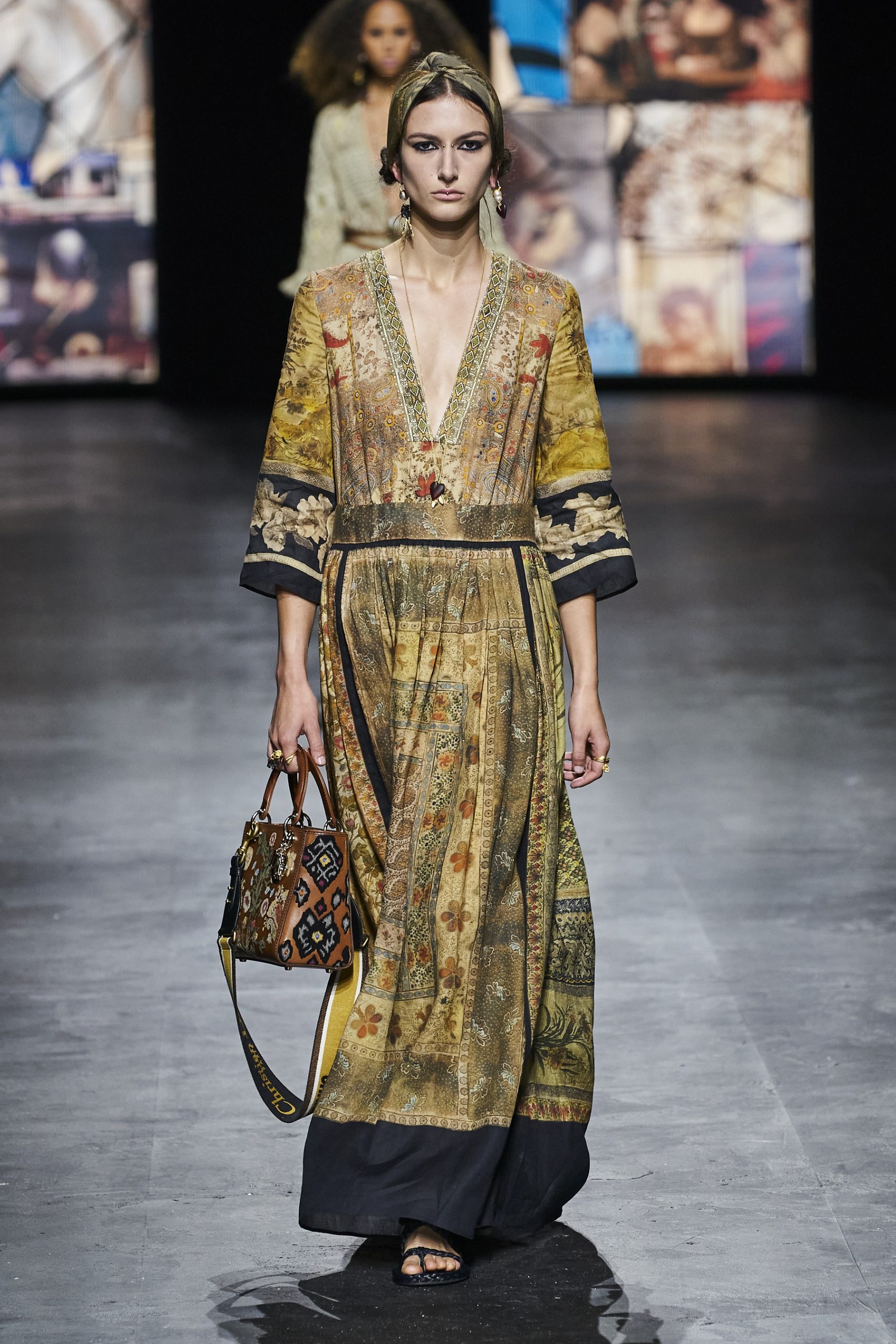
For Chiuri, the Dior creative director, designing fashion is first and foremost an intellectual process that begins not with just the meticulous details of draping a new shape or choosing a fabric but in situating these potential new clothes where they can belong on the pedestal of other creative expressions namely the visual arts.
“The time has now come for fashion to decipher its latent forces and desires and recognize itself as a free and original discipline,” was a quote that the art critic and curator Germano Celant wrote for the 1997 Florence Biennale titled ‘Il tempo e la moda’.
The process of fashion at Dior is distinct and unique in its rigorous adherence to the house’s heritage of art and intellect – these domains of the mind remain central to the Dior ethos today. Since her arrival in 2016, season after season Chiuri has treated her audience to a strong dose of thinking – about societal relationships, about the role of women, and about the role that clothes played in the parlance of daily lives. In connecting with the art world and in linking together, Chiuri is like a master curator speaking to her audience imbuing her clothes with the values of art not just only the heritage of Dior.
Every Chiuri show has reflected that words matter, just as much as her reinterpretations of the Dior silhouettes and her own manifestation of the Bar jacket, now in this spring season sees its newest incarnation as a loose fit collarless jacket in the shape of a karate uniform jacket with front patch pockets in tropical wool of in colorful Indonesian tie dyed ikat cotton tied at the waist and paired with a denim shirt and stripe short skirt or over knit long fringed skirt.
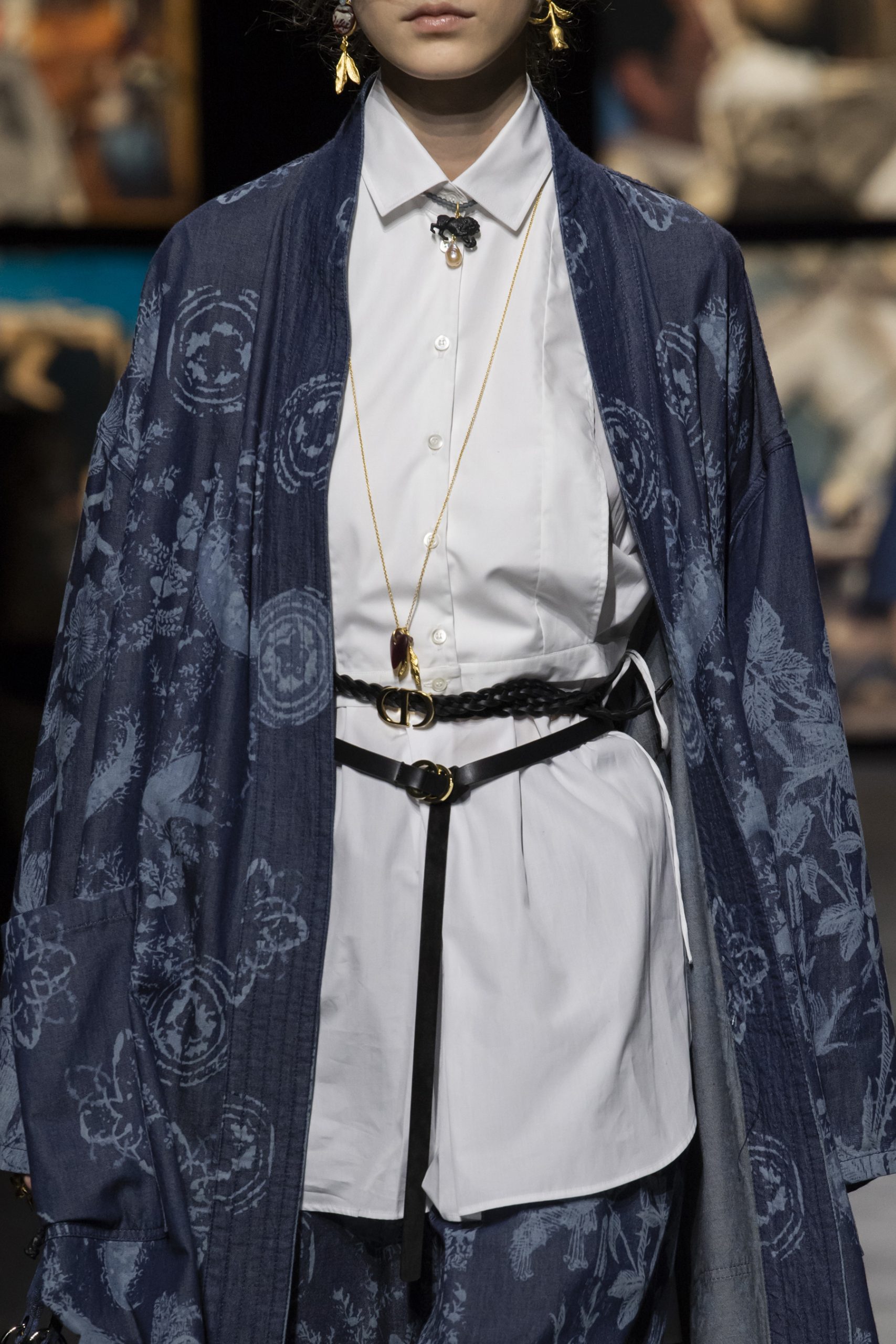
As the models walked around and in front of the collage art pieces created by Marcucci as stain glass windows in the show stage set that surrounded the limited audience, these art and the women singers who performed live became an intrinsic part to visualize artistically the particular process of creation at Dior and specifically creation of the clothes. The immersive pictorial language coupled with the aural sound made these loose and relaxed silhouettes that permeated throughout the show more lively especially in outfits like those great silk paisley long dresses with fringe trims and the range of ikat dyed fabrics from the sporty anorak and oversized pants to the bathrobe coat and loose pants.
“I found this sketch in the archive from Mr. Dior from 1957 that was made specially for Japan collection where the construction of the jacket was completely different because it was a coat or a jacket that a person used at home. So the idea was to realize clothes where you feel confident as if you were wearing them at home because I think we are living in a different mood than in the past. For me, this also reflects in the choices of materials because I chose materials more soft and very light and a lot of knitwear,” Chiuri said when I asked about how she made her decision about choosing one particular drawing from 1957 to spawn an idea of this collection revolving around the mood of the home and the mood for clothes that are familiar and easy to wear.
That meant patchwork long print chiffon dress under a v-neck knit cape, slim column silk print long dress, or a blue denim print long Bar coat with matching boxing short pants and long white shirt. Even the new incarnation of the Bar in blue linen with light grey linen flare skirt with a small string belt around the waist and a navy cotton tank underneath did not have a feel of formality espoused by any previous versions of the Bar. In fact none of these new Bar inspired jackets and coats looked formal in anyway even those made with the traditional navy wool instead of print denims.
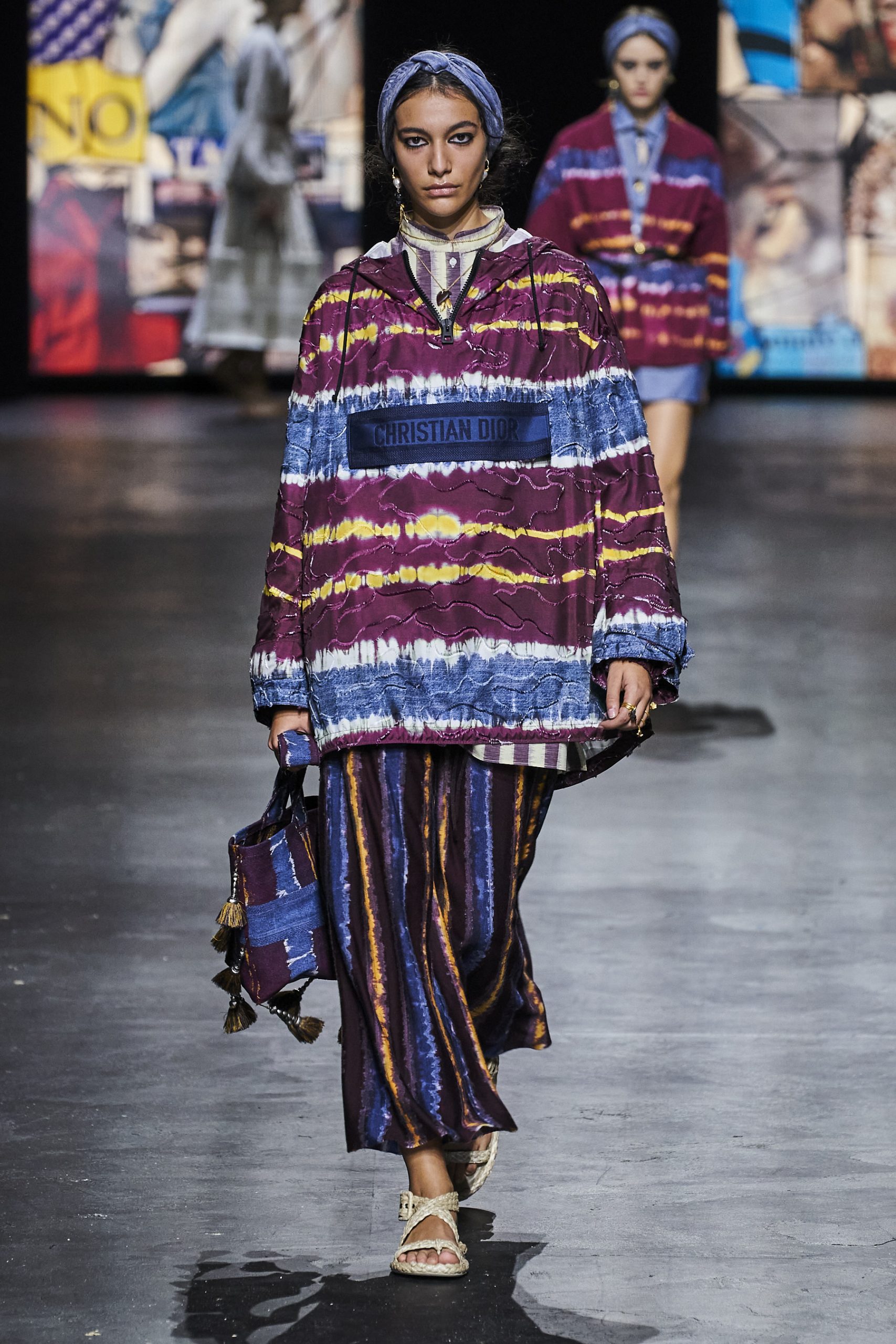
Those ikat fabrics on the garments shown were all hand made by women artisans in Indonesia. “It is also a dialogue about different techniques about textiles. You can put together different clothes for a wardrobe that is very different from the other collections. It is also about celebrating the work done by women in different countries. Even in Italy we lost a lot of the tradition because there is less interest from the young generation in these types of crafmanships,” Chiuri said. For Dior previous cruises seasons, Chiuri engaged with local artisans in Morocco and in the south of Italy. The clothes surely don’t feel or scream fashion say perhaps the blue logo print pants carefully slightly hidden under a long coat but more like the kind of clothes that have always been around in the wardrobe closet.
“I want to celebrate in a quiet feeling the work of the artists – the cathedral of visual poetry as they called their work and also a reflection about this time – an intimate space where we can think,” Chiuri said about the stage set constructed in a way that resemble the interior of a church. But I think there may be something else in this quiet and reflective setting.
Dressed with all the possible accouterments in the assembly of arts and high fashion from the theoretical Germano Celant to the expressive collage art pieces of Lucia Marcucci to the moody expressive filming by Alina Marazzi whose ultra short teasers caused existential angst, what is missing in this Dior show is the emotion, if even raw feelings.
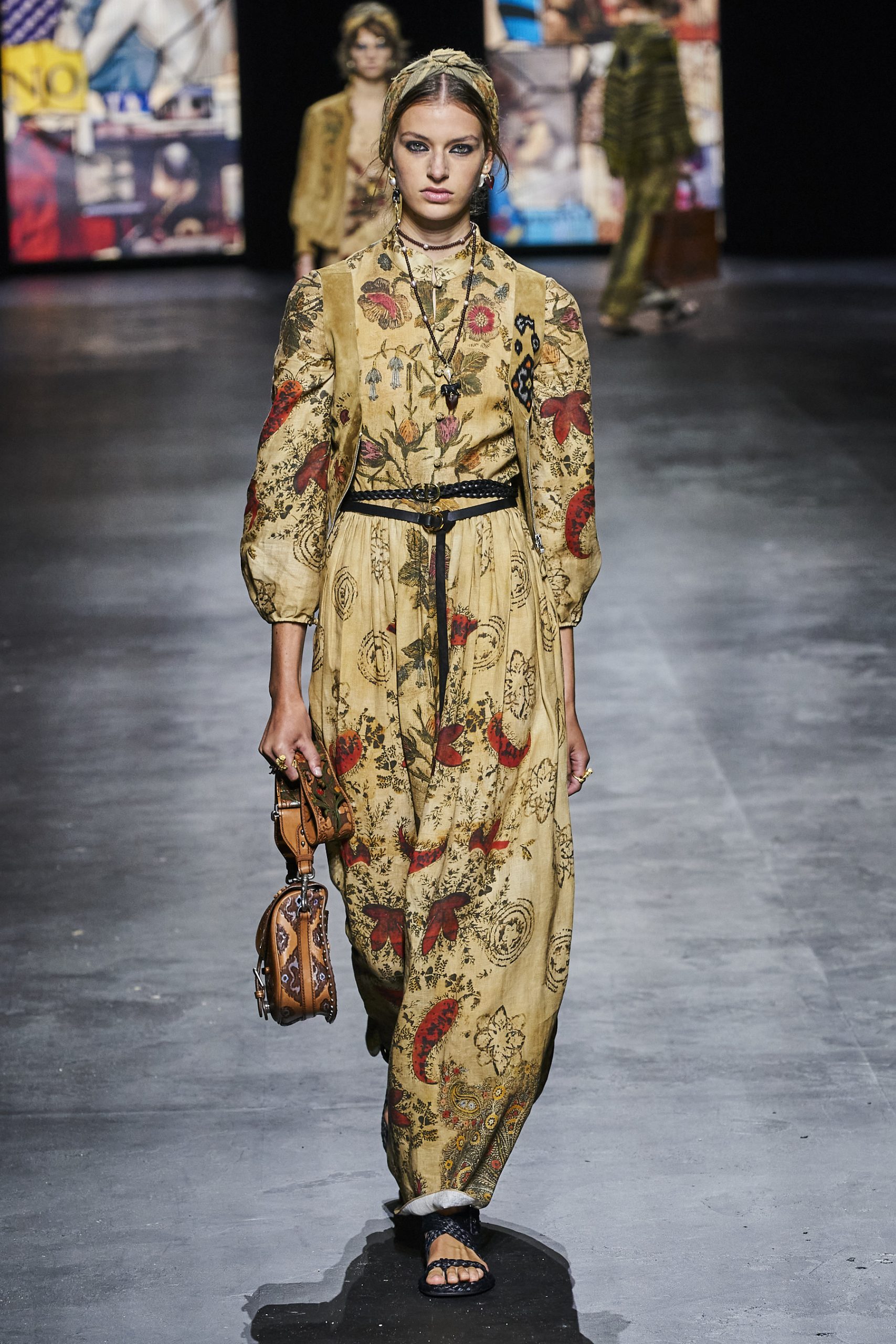
The real emotions from the show came from the twelve singers from the vocal ensemble Sequenza 9.3 directed by the group founder Catherine Simonpietri. You can see that clearly every time a model walked by each of the singer performing the ‘vocero’ with their deep voices expressing the sorrows of loss in the words of the song.
The eagerness at Dior to explain, to justify and to rationalize the fashion aesthetics and the clothes comes as a priority rather than simply talked about the urges to feel and to appeal to the heart. Perhaps the intellectual heritage of Dior dictates this route as the defense for the house 1947 New Look rested in the justification as a celebration of liberty rather than just getting women to feel their clothes again after the strenuous war years. Dior rationalized the clothes at the time then and also now in manners that superseded the needs that simply these clothes were and perhaps are the right feels and sentiments for their respective times.
Imagine yourself as that woman in the teaser short at Dior’s Instagram looking bewildered at the collage art in front of her – she looked inquisitive and curious but she displayed no emotion. We don’t sense her fear, her loneliness or her fright. This has been a struggle for Dior, a house founded on intellectual principles rather than fashion as an emotion connection to people and to consumers. But then at the top of the Dior Instagram account is a quote from the founder – “Women, with their intuitive instinct, understand that I dreamed not only of making them more beautiful, but happier too.”
Intuition, understanding but not feeling. That is perhaps why at times the clothes often seem distant, fabulously made, but still distant.
That said, however, this show did have the audience more involved emotionally than any of Chiuri’s previous shows. There was something, probably experienced differently on the grounds, today. Perhaps it was in the manners of the models as they meandered around the fabulous set constructed by in a tent at the Tuileries gardens where the music from composer Lucia Ronchetti could easily pierced the parachute fabrics enclosing the stage performed by a vocal ensemble Sequenza 9.3 directed by Catherine Simonpiretri chanting repertoire ‘Sangu di Rosa’ in the manners of funeral ceremonies. Perhaps it was the fact that this fashion ‘ritual’ took place at all under these circumstances and took place in such a majestic and uncompromising way. Or even perhaps that one has to carefully look at the whole mood to see the emotion of hope in the girls walking in front of a stain glass window with partial images recomposed from torn pages with the remants of partial word like ‘The Spirit’, ‘nuovissima’, ‘NO’, ‘rischi’ spread among photos of bird eyes, man’s ears, or a naked torso.
